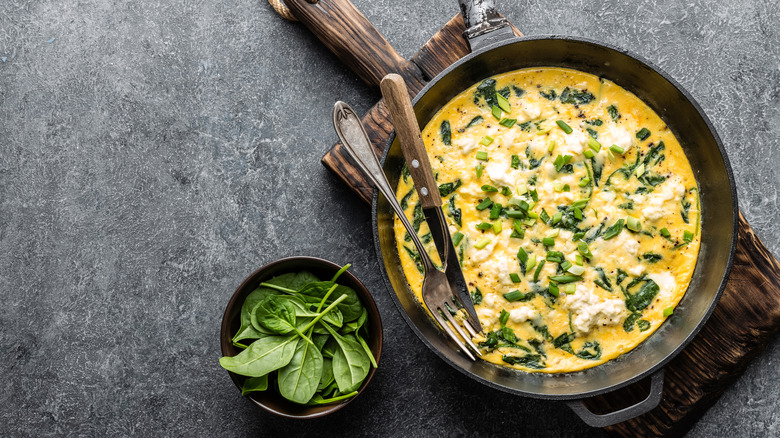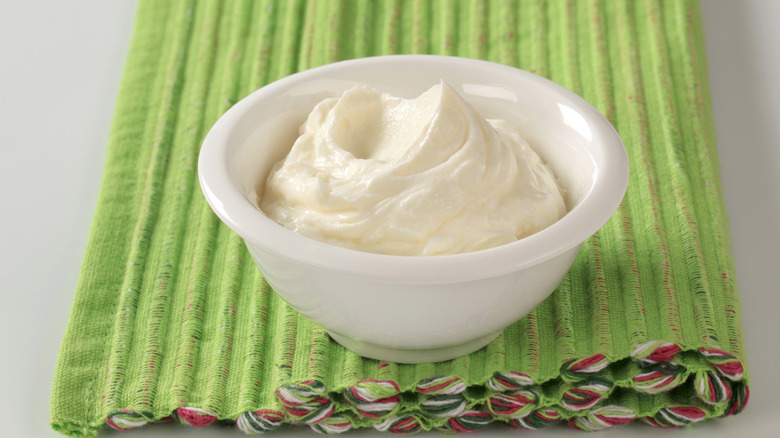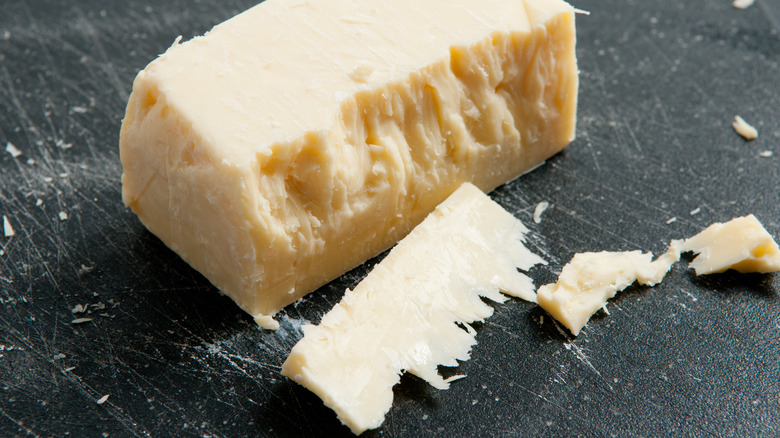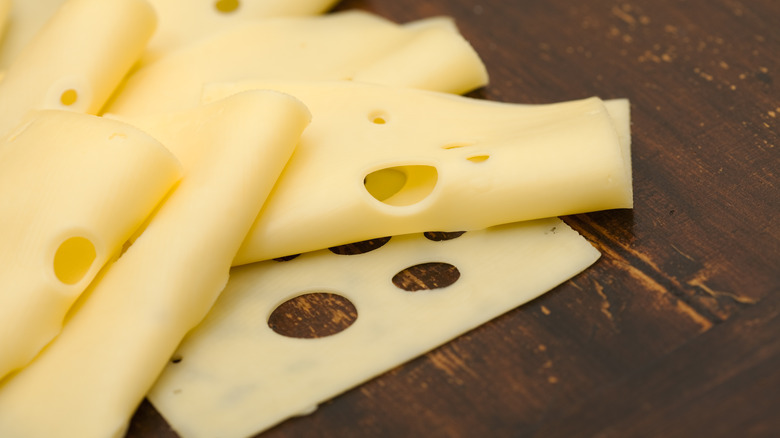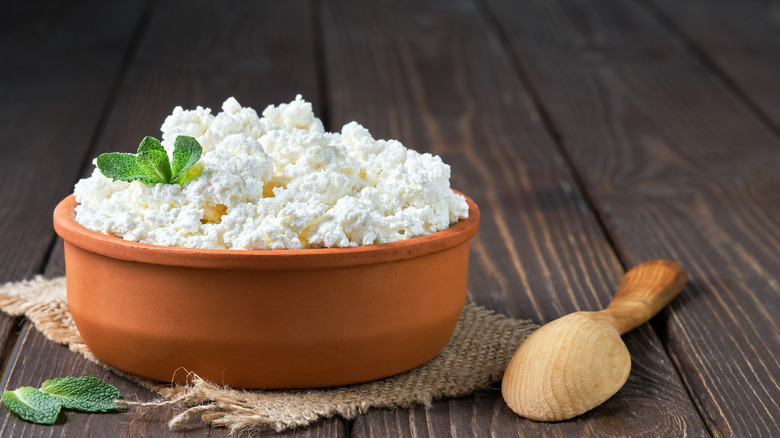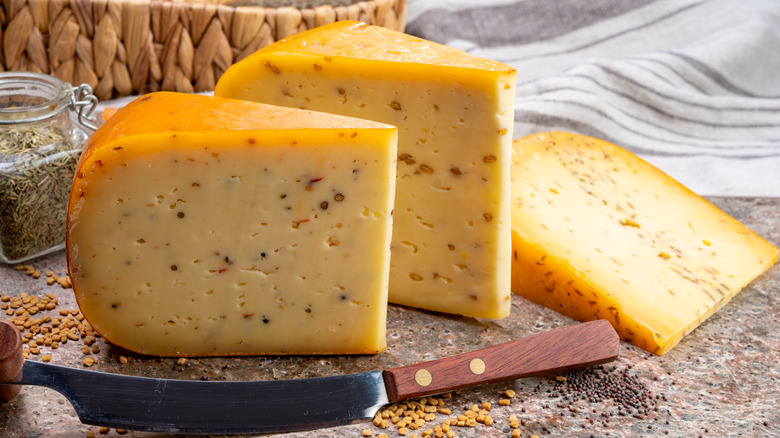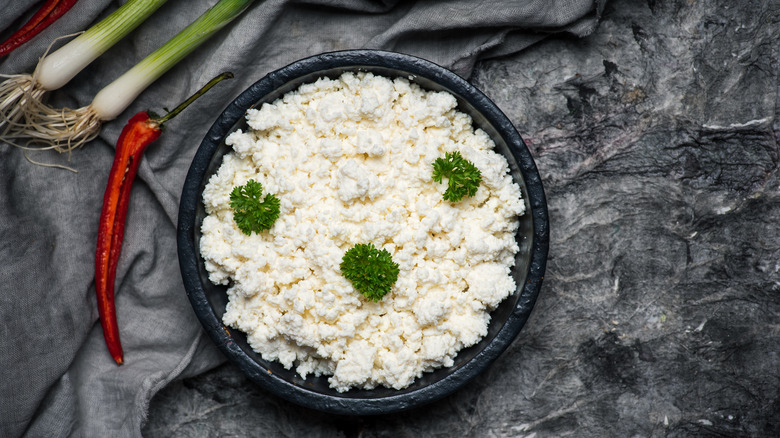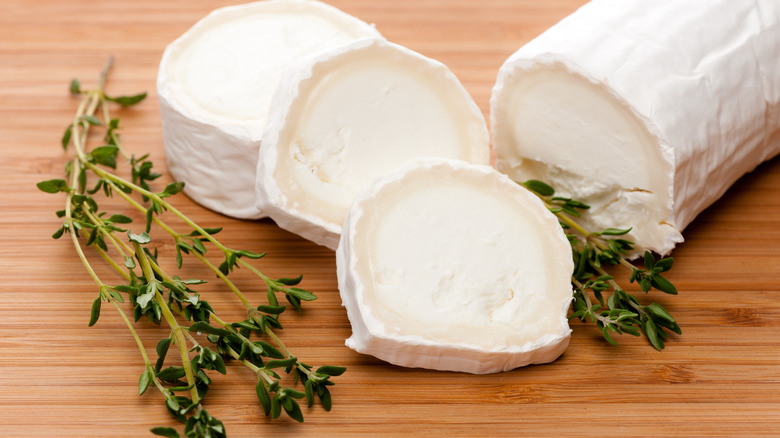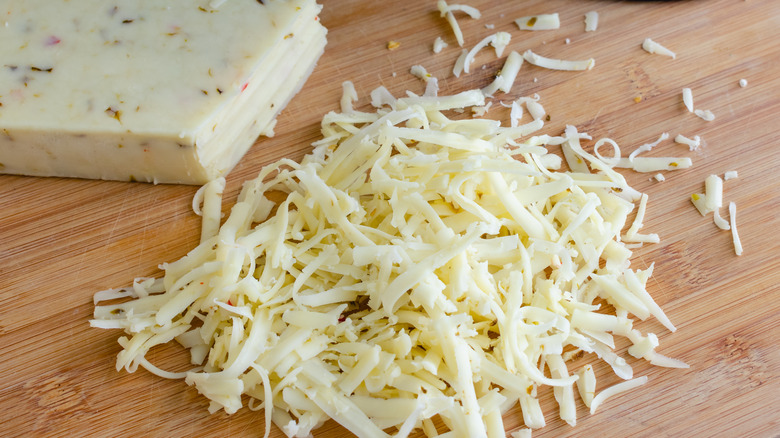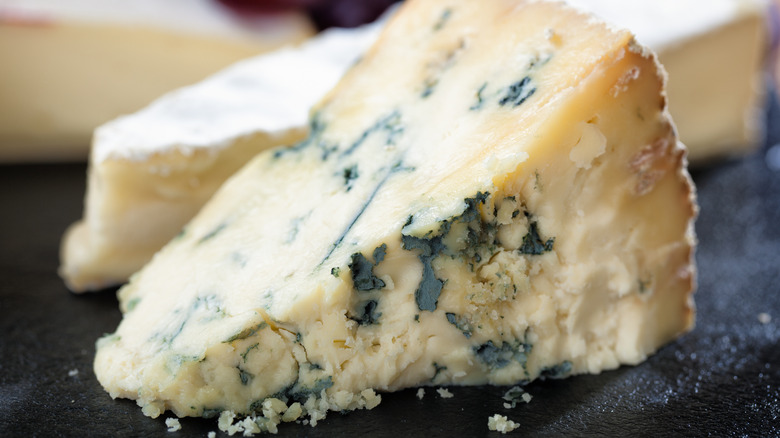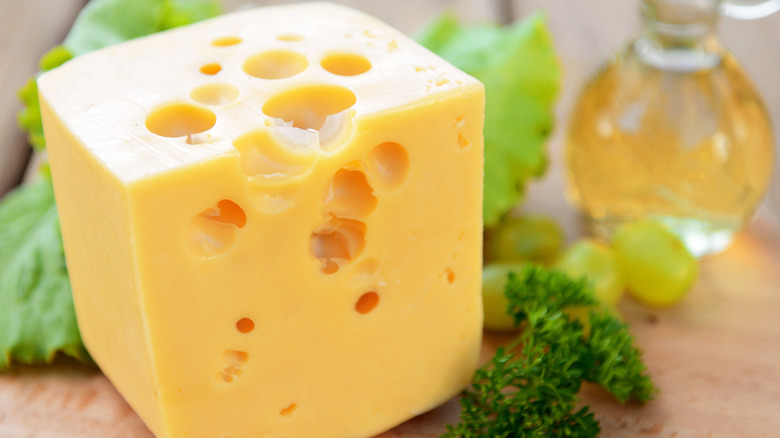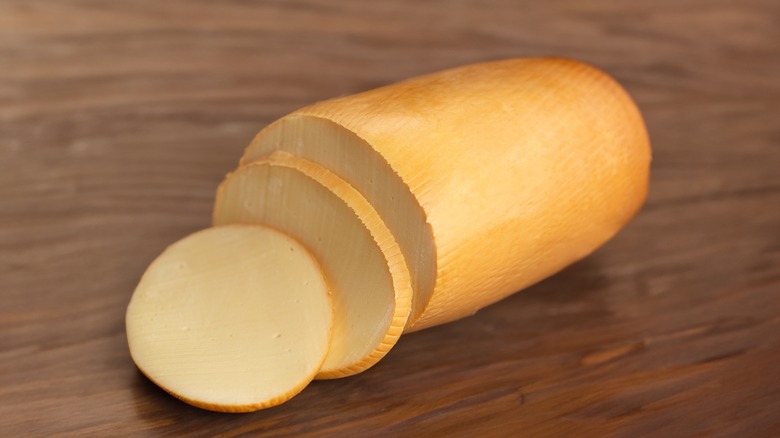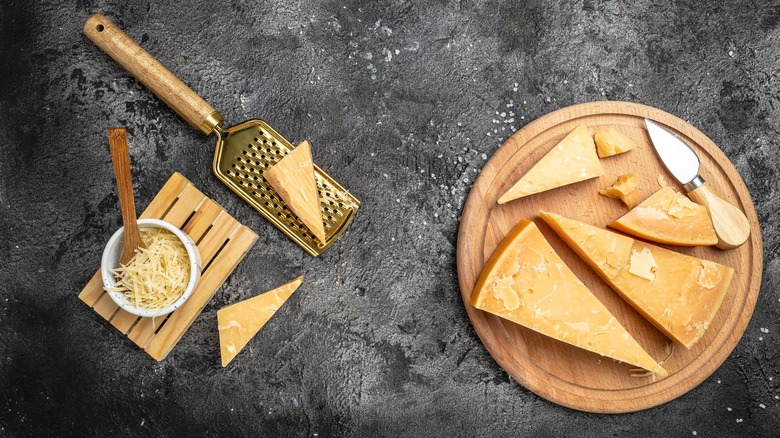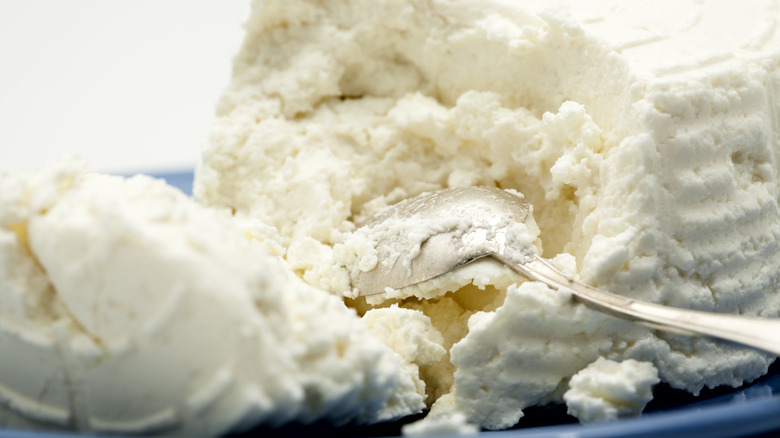13 Cheeses That Are The Perfect Addition To Scrambled Eggs
Breakfast might be the most important meal of the day, but for some of us, it can get a little boring. When you have time to indulge in more than a muffin on the go or a quick bowl of cereal, your thoughts might turn to scrambled eggs.
There is no need to throw the (egg) baby out with the bathwater, though. Welcome to the world of culinary magic, where the simple act of adding cheese to scrambled eggs transforms breakfast into a symphony of flavors. Imagine your morning eggs, soft and perfectly scrambled, with a velvety blanket of cheese gently melting, creating a harmonious blend of creamy richness. Now, picture a few targeted accompaniments, elevating your daily breakfast into something extraordinary.
All of this is possible with minimal cooking experience and very little effort. Cheese adds flavor, texture, and depth to your morning eggs and can be added at the very last minute. When it's time to make some changes to your morning routine, here are cheeses that are excellent additions to scrambled eggs.
Mascarpone
Mascarpone cheese is a luscious, indulgent dairy product from Italy's Lombardi region. This cheese is created by straining the whey without compressing the cheese before adding citric acid. The result is a cheese with a creamy finish and a sweet, slightly tart taste.
Its smooth texture is most familiar to tiramisu lovers, but mascarpone also adds a beautiful finish to soft scrambled eggs. The secret? A high butterfat content, between 60% and 75%, that means a little goes a long way.
To add a bit of luxury to your soft scrambled eggs, crack fresh eggs into a high-sided saucepan. Add butter in a 2-to-1 ratio (eggs to butter), then put the pan over high heat, stirring constantly. Stir over high heat for about 30 seconds. Move the pan off and keep stirring for ten seconds. Return to high heat, then remove and stir. Repeat this until curds begin to form (about three minutes total). Remove from the heat, season, and add one heaping teaspoon of mascarpone. Stir, season, and serve.
Cheddar
Cheddar is one of the most popular and familiar cheeses in the U.S. Many people think only of a bright orange block or shreds when they think of cheddar. This versatile cheese is so much more than that, with a wide range of flavors that develop over time as it ages. Mild cheddars are aged for just a month or two — long enough to develop cheddar's signature tang — but sharp and extra sharp cheddar sits in the aging house for a year or more. Over time, the flavor deepens, and the texture becomes craggy. Aged cheddar breaks off with jagged edges rather than smooth slices.
The color of cheddar has nothing to do with its flavor. Orange cheddar cheese has been colored with annatto, a plant-based food coloring harvested from annatto trees. Coloring is added for consistency — cow's milk changes color depending on their diet, and not every consumer is ready for that.
But both mild and extra sharp cheddar work well with scrambled eggs. For easier melting, add shreds or small cubes when your eggs are nearly finished. If your cheese is not melted by the time your eggs are cooked, remove the eggs from the heat and cover the pan for a few seconds to finish melting.
Swiss
Swiss cheese is the name given to more than one cheese. In the U.S., grocery store Swiss cheese is a version of Emmental cheese from Switzerland. It is pale, with a mild, slightly nutty flavor. The holes in Swiss cheese (known as eyes) are created during cheesemaking, a process designed so that no rind forms. If the cheese has no eyes, it's called blind Swiss, and the flavor will be mild. If you like a bold taste, look for larger eyes, and lots of them.
Along with ham, Swiss cheese is one of the stars of Chicken Cordon Bleu. Recreate this classic flavor combination in your scrambled eggs by chopping or dicing ham (or using lunchmeat ham cut into slivers). Ham can be added as the eggs begin to form curds, with Swiss cheese coming in at the last minute. Lay a slice or two of Swiss cheese over the eggs, remove the pan from the heat, and cover it. Let the cheese melt, then sprinkle with freshly cracked black pepper and serve.
Cottage cheese
Cottage cheese is having a moment. This protein-packed dairy product has been instrumental in helping many people boost their protein intake and is a key ingredient in everything from pasta to pudding. Cottage cheese is available in large- and small-curd, with a texture that some people love (and others love to hate). It's created by adding acid to milk and allowing curds to form before straining the whey and salting the cheese, and it's a perfect addition to scrambled eggs.
Add cottage cheese to your scrambled eggs in a couple of different ways. The first is to simply stir a few tablespoons into your eggs as they cook. Wait until the eggs start to form curds, then add cottage cheese and keep cooking the eggs until they are done to your liking. If you want to dip your toe in more slowly, add them as a topping once your eggs are cooked. Chop up some fresh chives and stir them into your cottage cheese along with black pepper. Add as much as you like to your eggs, and dive in. The contrasting hot and cold, plus the still-firm texture of the curds keeps things interesting.
Still not convinced? Cottage cheese makes a great bread spread for a scrambled egg sandwich. Add it to a food processor along with a little pepper and process until smooth. Spread on toast and top with eggs.
Gouda
Gouda cheese is a pressed, uncooked cheese that hails from the Netherlands and is the favorite cheese in that country (along with Edam, also a Dutch cheese). It's made from skimmed milk, which means it's a lighter cheese if fat intake is a concern. Gouda of every variety comes in a red wax rind that is not edible.
Gouda comes in various forms, including young, aged, and smoked. Some cheesemakers add spices and seasonings to their cheese, including carraway, cumin, thyme, and rosemary. Any variety works beautifully in scrambled eggs, and the addition of spices adds flavor and depth. As with other cheeses, the older the Gouda, the stronger the taste. But beware: The longer Gouda sits in the fridge, the less flavorful it becomes. Don't spend lots of money on a Christmas Gouda (aged 36 months) and ration it out over a month. Consume your cheese within two weeks of purchase (and less is better).
Add Gouda of any variety in the same way you would other cheeses. You could also make Gouda cheese toast and top it with soft scrambled eggs. This brings out the flavor of the cheese and adds another creamy element.
Feta
Feta cheese originated in Greece and is traditionally made of goat or sheep milk (although blends with added cow's milk are also available). It's crumbly, salty, and packed with flavor. Feta makes up 70% of all cheese consumption in Greece. Its crumbly, open texture is created by pickling or submerging in brine, but the texture and flavor also depend on the age of the cheese. Feta is generally a young cheese, though, and only those products made in Macedonia, Thrace, Thessaly, Central Mainland Greece, the Peloponnese, Lesvos, and the Island of Kefalonia can bear the name (the European Union protects it).
Add crumbled feta and sundried tomatoes to your scrambled eggs for a delicious trip to the Mediterranean without leaving your home. It's easy to add texture here, too, by adding feta and chopped sundried tomatoes to a hot pan and allow it to melt and get a bit of a crispy crust before adding your beaten eggs. Cook until the texture of the scrambled eggs suits you, then remove from the heat and add a chiffonade of basil. Stack basil leaves, then roll tightly before slicing from the tip of the leaf to the stem to form ribbons of basil. Season with fresh pepper and enjoy.
Goat cheese (chèvre)
Goat cheese is also known by its French name (chèvre — the word for goat in French). This creamy, soft cheese is tangy and tart, the perfect bump in flavor for scrambled eggs. Goat cheese comes in a spreadable form or in crumbles. The difference in forms is aging, with young chèvre more likely to be softer in logs or rounds and older chèvre as a crumbled product. Either way, goat cheese scrambled eggs are delicious, an elevated version of the old breakfast standby. To add chèvre, the best method is low and slow in a high-sided saucepan. Start by melting butter in the saucepan, then add beaten eggs and stir constantly. This requires patience, as curds form very slowly over low heat.
As the curds begin to form, add a couple of tablespoons of goat cheese and keep stirring until the eggs are fully cooked. Remove from the heat and season. Be careful with the salt; some goat cheese is salty — balance is key. Another great finishing touch is chopped chives or thinly sliced scallions.
Monterey Jack
It's a Jack of all trades, Monterey Jack cheese. Monterey Jack is the original American cheese, originating in the monasteries of Monterey, California, in the 1700s. It's as comfortable on a sandwich as it is in a sauce or casserole. Jack cheese is mild and melts beautifully, making it the perfect scrambled egg addition. You can have it in its plainest form — Monterey Jack — or try other versions, like Pepper Jack or Colby Jack. Both of these still retain the perfect melting qualities of the Jack but add another flavor dimension.
Because of its superior melting, Monterey Jack is often used in Mexican cuisine. Take this flavor profile as inspiration for your scrambled eggs and add tomatoes, onions, and green chiles. Chop veggies and cook them before adding beaten eggs and seasoning with salt. Cook until nearly done, then fold in your Monterey Jack cheese. You can add canned black beans at this stage, too. Serve with warm tortillas, fresh avocado or sour cream, and fresh chopped cilantro.
Blue cheese
That funky mold, that acquired taste. Blue cheese is the generic name for a variety of cheese with a delicious moldy vein running through it. Many blue cheese varieties (for example, Stilton) are named for the region in which they are produced, with a flavor profile that is specific to that area. Regardless of the region, the basic process is the same: Mold is added to the cheese curds before they are shaped into wheels, and then the wheels are left to age. The resulting flavor is bold and pungent, the perfect contrast to the mild creaminess of scrambled eggs.
For best results (and to let eaters add as much as they like), blue cheese is best added to scrambled eggs after cooking. Serve blue cheese crumbles at the table, and let diners do the honors. Balance that funk with a dollop of mascarpone or salty bacon crumbles for an even more elegant experience.
Gruyère
Gruyère's proper name is Le Gruyère AOP, and it's protected by French law. Making Gruyère is strictly regulated, and only cheese that conforms to the process is awarded the coveted name. It's another unpasteurized Swiss cheese that ages with holes of varying sizes. The size of the holes predicts both the cheese's flavor and age, with young cheese having smaller holes and a mild nutty flavor. As the cheese matures, the texture gets more grainy, and the cheese begins to crack. A fully aged Gruyère cheese is ready at one year.
A cheesemonger will offer more varieties and ages of Gruyère than your garden-variety grocery store, but any age of this cheese is delicious in scrambled eggs. The younger cheese melts smoothly and imparts a nutty flavor, while its elderly relations have a deeper, more complex flavor and texture. Add either age at the end of cooking, and consider adding some caramelized onions (or fried onions as a garnish).
Provolone
Buttery taste, easy melting texture: Provolone cheese was tailor-made to pair with scrambled eggs. This Italian semi-hard cheese is usually presented in thin slices at the cheese counter, and these are perfect for the finishing touch on eggs. There is more than one flavor profile of provolone, depending on the region in which it is produced and the age. Younger provolone is sweeter, but as it ages, the sweetness is replaced with the characteristic tang that makes it so delicious on your favorite Italian sandwich.
For scrambled eggs, consider adding other components that highlight this cheese's origins. Take a cue from the muffaleta sandwich and chop up some olive salad and artichoke hearts as a garnish. Add provolone slices to your scrambled eggs when they are finished cooking, then cover and remove them from the heat while the cheese melts. Another way to capitalize on provolone's flavor is to add a splash of tomato sauce to your scrambled eggs after they are cooked. Provolone pairs well with fruit, and the sweetness of the tomato (itself a fruit but used in savory dishes) balances the salty creaminess of provolone.
Asiago
Asiago is another protected Italian cheese that makes for a beautiful, unexpected breakfast. It comes in two forms: fresh Asiago with a smoother texture and older versions that become crumbly and resemble its close relative Parmesan. This cheese develops tiny holes, and pinpricks in comparison to Swiss cheeses, and the flavor deepens as it ages.
For an amazing twist on the Italian classic pasta dish cacio e pepe, select an older Asiago cheese and grate it finely (not shreds — you want a very fine consistency). Add a ¼ cup of grated Asiago for every four eggs. Beat these ingredients together (skip the salt for now — Asiago is very salty on its own). You do not want to add pepper at this stage, as it will make your final dish an unappetizing grey color. Melt butter in a skillet over medium-low heat and add the eggs. Stir constantly as curds begin to form. Once you have scrambled the eggs to your liking, remove them from the heat and grind a ton of pepper onto them. Pass additional Asiago, and provide a salt shaker for those who want it.
Ricotta
When you're looking for the smooth luxury of mascarpone but your budget is a little less bougie, reach for ricotta. Ricotta cheese is mascarpone's less affluent cousin, with just a bit more texture. You can buy ricotta in the store or make it yourself by adding acid to whole milk, waiting until curds begin to form, then straining the whey. Other ricotta-like options include farmer's cheese and quark (rare in the U.S. but widely available in Europe).
Ricotta makes for a lovely loose scramble, a softer texture that is delicious when served over buttered toast. you can also season or flavor your ricotta and use it as a garnish or a finishing touch. Another way to utilize this creamy dairy product is to use it as a spread for whatever bread product you are serving. It's delicious on a fresh biscuit or leftover hunk of sourdough, topped with soft scrambled eggs and a sprinkling of chopped chives.

